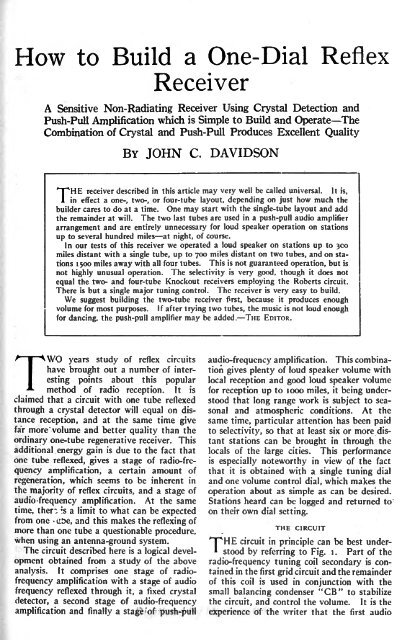Radio Broadcast - 1925, February - 113 Pages ... - VacuumTubeEra
Radio Broadcast - 1925, February - 113 Pages ... - VacuumTubeEra
Radio Broadcast - 1925, February - 113 Pages ... - VacuumTubeEra
Create successful ePaper yourself
Turn your PDF publications into a flip-book with our unique Google optimized e-Paper software.
How to<br />
Build a One-Dial Reflex<br />
Receiver<br />
A Sensitive Non-Radiating Receiver Using Crystal Detection and<br />
Push-Pull Amplification which is Simple to Build and Operate The<br />
Combination of Crystal and Push-Pull Produces Excellent Quality<br />
BY JOHN C.<br />
DAVIDSON<br />
THE receiver described in this article may very well be called universal. It is,<br />
in effect a one-, two, or four-tube layout, depending on just how much the<br />
builder cares to do at a time. One may start with the single-tube layout and add<br />
the remainder at will. The two last tubes are used in a push-pull audio amplifier<br />
arrangement and are entirely unnecessary for loud speaker operation on stations<br />
up to several hundred miles at night, of course.<br />
In our tests of this receiver we operated a loud speaker on stations up to 300<br />
miles distant with a single tube, up to 700 miles distant on two tubes, and on stations<br />
1<br />
500 miles away with all four tubes. This is not guaranteed operation, but is<br />
not highly unusual operation. The selectivity is very good, though it does not<br />
equal the two- and four-tube Knockout receivers employing the Roberts circuit.<br />
There is but a single major tuning control. The receiver is very easy to build.<br />
We suggest building the two-tube receiver first, because it<br />
produces enough<br />
volume for most purposes. If after trying two tubes, the music is not loud enough<br />
for dancing, the push-pull amplifier may be added. THE EDITOR.<br />
years study of reflex circuits audio-frequency amplification. This combination<br />
gives plenty of<br />
have brought out a number of interesting<br />
points about this popular<br />
TWO loud speaker volume with<br />
local reception and good loud speaker volume<br />
method of radio reception. It is for reception up to 1000 miles, it<br />
being understood<br />
that long range work is<br />
claimed that a circuit with one tube reflexed<br />
subject to seasonal<br />
and atmospheric conditions. At the<br />
through a crystal detector will equal on distance<br />
reception, and at the same time give same time, particular attention has been paid<br />
far more volume and better quality than the to selectivity, so that at least six or more distant<br />
stations can be brought in through the<br />
ordinary one-tube regenerative receiver. This<br />
additional energy gain is due to the fact that locals of the large cities. This performance<br />
one tube reflexed, gives a stage of radio-frequency<br />
amplification, a certain amount of that it is obtained with a single tuning dial<br />
is especially noteworthy in view of the fact<br />
regeneration, which seems to be inherent in and one volume control dial, which makes the<br />
the majority of reflex circuits, and a stage of operation about as simple as can be desired.<br />
audio-frequency amplification. At the same Stations heard can be logged and returned to<br />
time, ther~, ; s a limit to what can be expected on their own dial setting.<br />
irom one iibe, and this makes the reflexing of<br />
more than one tube a THE CIRCUIT<br />
questionable procedure,<br />
when using an antenna-ground system.<br />
The circuit described here is a logical development<br />
obtained from a study of the above radio-frequency tuning coil secondary<br />
THE circuit in principle can be best understood<br />
by referring to Fig. i. Part of the<br />
is contained<br />
in the first grid circuit and the remainder<br />
analysis. It<br />
comprises one stage of radiofrequency<br />
amplification with a stage of audio of this coil is used in conjunction with the<br />
frequency reflexed through it, a fixed crystal small balancing condenser "CB" to stabilize<br />
detector, a second stage of audio-frequency the circuit, and control the volume. It is the<br />
amplification and finally a stage of push-pull experience of the writer that the first audio
















